The Life and Times of “Chuck” – A Very Special TV Series Begins its Final Journey

I first heard about Chuck in a movie theatre during the summer of 2007; that was the season NBC began advertising new shows during the pre-movie commercial blocks, and though the swiftly-cancelled Bionic Woman received the majority of the hype, there was always room for a brief Chuck ad. I was intrigued; it was hard to tell just what Chuck was from these ads. The show was an enigma, and out of curiosity, I watched the pilot when NBC made it available OnDemand. As soon as I finished watching, I began singing its praises to everyone I knew, the first bit of campaigning I did for the show. When it premiered on Monday, September 24th 2007, I sat my parents and brother down in front of the TV and made them watch it again with me; they too agreed that this quirky spy comedy had potential.
Who wouldn’t think that? By the forty-minute mark, there were many signs that Chuck was something special. The characters were all well-defined and endearing from the outset, the Intersect brought with it some compelling mythology, and Chuck’s first adventure wasn’t just a throw-away exposition skeleton, but a fun spy story in its own right. There were classic moments like Chuck singing the “Vicky Vale” song as Sarah walks up to the Nerd Herd counter for the first time, Morgan and Chuck being confronted by a computer-stealing ninja at the apartment, and of course, Chuck disarming a bomb with the “Irene Demova” virus (i.e. using pornography to save the day!). But it was one of the final scenes that really indicated this show had the heart to go the distance:
Chuck is sitting on the beach, depressed about his new status quo, when Sarah comes in to comfort him. On page, this scene isn’t anything special, just summarizing exposition; but Zachary Levi and Yvonne Strahovski’s chemistry was so palpable, the heart and soul they lent these characters so vivid, that it was impossible not to fall in love with Chuck that very moment.
“I need you to do one thing for me,” Sarah says. “Trust me, Chuck.”
Trust he did. Trust we did. Five years and seventy-seven episodes later, I think few fans can properly explain the gifts that trust earned. Tomorrow night, Chuck begins its fifth and final season on NBC. It’s been a hell of a ride, and after the jump, I’d like to trace some of the major moments in the life of this incredible show.
As the first season went along, it became clear that the pilot was no gaffe – Chuck was something special, and after the weak second episode – still the worst hour of the show to date – the series just kept getting better and better with each passing hour, exploring all of the characters, their relationships, and the mythos of Chuck’s world. This was a show that somehow combined Office-style workplace humor in an electronics store, family drama (Chuck and Ellie), serious espionage stories (the return of Bryce Larkin), hilarious spy antics (Chuck blowing up Casey’s beloved Crown Vic to save the day), will-they-won’t-they romance between the two leads, and a whole lot of referential geek humor into one seamless package. From the beginning, Chuck wanted to be a whole lot of things at once, and though the early episodes struggled at times to make that balance work, it was never anything less than entertaining to watch.
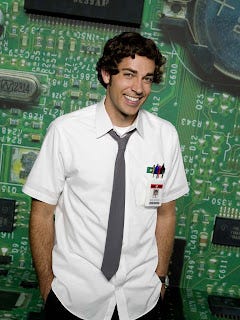
I think all fans agree that it was the characters that drew us into this show and have kept us watching ever since. As played so wonderfully by Zachary Levi, Chuck himself seemed to embody many of us in the audience: an insecure geek not making use of his full potential. Especially in those early days, Chuck was an incredibly easy character to relate to and invest in, and that made all the crazy ups and downs of his spy life more palpable, from pining for the gorgeous, talented spy handler to the thrills of flying a helicopter to using sheer intelligence and willpower to save the day. Very little in Chuck is objectively realistic, but Zachary Levi is so earnest and genuine as the title character that any subject matter is fair game; the actor and the character ground the show in entertaining and endearing ways, and at least for those who watch the show, Chuck Bartowski will go down in history as one of the all-time great TV protagonists.

But as I’ve long said, it’s Yvonne Strahovski’s Sarah Walker who does the most to give the show its dramatic, beating heart. Sarah’s evolution over the years has been nothing short of extraordinary, one of the best ongoing character arcs in recent TV memory, but even at the outset, she really made the show click. Whether struggling to cook hot dogs at the Wienerlicious (remember that?), kicking ass against a large array of baddies, or comforting Chuck when the spy life got too stressful, Sarah was an instantly winning character, and though Strahovski has only gotten better with time, she performed her part in leading the show beautifully. Looking back at season one, Sarah wasn’t quite the three-dimensional character she would become; her arc and development was really subsidiary to Chuck’s. Even her most emotionally open moments – usually coming from grief at the loss of former boyfriend/spy-partner Bryce Larkin – were narratively designed as roadblocks to keep she and Chuck separate. But the building blocks for a great character were there right out of the gate, and it didn’t take long for creators Josh Schwartz and Chris Fedak to recognize the character’s untapped potential.

Adam Baldwin’s John Casey, on the other hand, came out of the gate fully formed, the gruff career-military man who was ultra-capable but socially inept. And somehow, we loved him right off the bat. That’s always been Baldwin’s specialty, though. Before Chuck he was best known to genre fans as Jayne Cobb from Firefly, a morally compromised character who nevertheless won over the hearts of the show’s viewers, and he even won smiles as the often detestable Wolf Mother in Full Metal Jacket fifteen years earlier. The writers initially had one mode for this character, but Baldwin brought a three-dimensional creation to the table, and by the season’s end, Fedak and Schwartz started to give Baldwin the material he needed to really make this character soar. One can point to “Chuck Versus the Crown Vic” as the roadmap for future Casey stories: Casey is attracted to something trivial (in this case, an automobile), and over the course of the adventure, learns to value his friends more (well, sort of…). The very next episode, “Chuck Versus the Undercover Lover,” expanded on this, as we learned that once upon a time, Casey did have the capacity to love. Fedak, Schwartz, and Baldwin have been doing riffs on these ideas with the character ever since, to increasingly large creative rewards.

Rounding out the main cast that year were Joshua Gomez’s Morgan and Sarah Lancaster’s Ellie, both defined by their relationships with Chuck. Morgan wouldn’t truly come into his own until season two, but I still loved the little bearded guy in those early days. His unwavering devotion to his best friend was never anything less than heartwarming, and the scenes Gomez and Levi shared were always gold. Still, if I could point to one relationship as the heart and soul of season one, it would be Chuck and Ellie; Lancaster and Levi are always brilliant together, perfectly portraying how much these siblings matter to each other, and through their interactions, giving the viewers an idea of Chuck and Ellie’s hard childhood, having to fend for themselves after both of their parents left. The episode “Chuck Versus the Sizzling Shrimp” was a crucial hour in Chuck and Ellie’s development, as we learn how functionally the pair have coped since their mother abandoned them. Other favorite characters appeared in the early days, such as Ryan McPartlin’s Captain Awesome, so universally beloved right off the bat that Fedak and Schwartz quickly abandoned an early story plan wherein Awesome was an evil Fulcrum agent.
In its first season, Chuck began demonstrating two unique qualities that would come to be defining strengths: first, the casting of Rachel Bilson in a midseason arc where her character, a deli owner, becomes romantically involved with Chuck proved to be the series’ initial instance of inspired guest casting. Bilson was so memorable, and the arc so well executed because of her, that last month, I checked out her new show on the CW, Hart of Dixie, just because of residual Chuck memories. Second – and more fully formed from the get-go – was the show’s eclectic and effective musical palette, scoring the show mainly on a healthy diet of Indie Music. Many of the songs used were unfamiliar with audiences, allowing the music to enhance the stories, rather than distract from them. When they do use popular music, they often do so in bursts of wondrous creativity, such as Neil Diamond’s “Love on the Rocks” playing as Casey climbs out of a pool to save his love interest in “Undercover Lover.” Music is something the show has always excelled at.
That first season was cut short, like many in the 2007-08 season, by the Writer’s Strike. NBC gave the show a full 22-episode order early on, but the strike hit after producing only 13 hours. After the strike, creator Josh Schwartz was given the option to do another few hours to complete the season, but he instead requested a full Season Two order and opted to put all creative energy into next year’s episodes. It’s one of the best behind-the-scenes decisions the show ever made; season one ended abruptly (although I’d argue episode 13, “Chuck Versus the Marlin,” is an effective stopping point), but season two benefitted hugely from the extra creative focus.
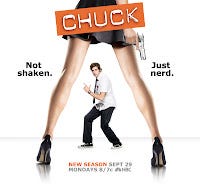
I’ve said it many times before and I will say it many times again in the future: season two of Chuck is one of the all-time great television seasons ever produced. Since production on season one stopped in late 2007, Schwartz, Fedak and company had a long time before the September 2008 premiere of season two, and they used that time to their advantage, ironing out every kink, fine-tuning each character, and prepping a wonderful set of story and character arcs that would play out over 22 glorious episodes.
Everything I loved about season one was enhanced tenfold in season two; characters who had existed only as distractions on the fringes, like Jeff, Lester, and Big Mike, came into their own as valuable pieces of the ensemble. The action and stunt-work, passable in the first year, was now more impressive and bombastic than anything on action-oriented programs like 24. There was humor around every turn, all funnier than ever before, but things also got darker. As Chuck’s spy life became more complicated and dangerous, the mythology deepening with every turn, the writers and the viewers really started taking these characters seriously. Chuck and Sarah’s relationship wasn’t just a week-to-week will-they-won’t-they tease, but an honest examination of how two people from such different walks of life could be destined for one another.

Each character had their own unique and impressive development – Morgan, for instance, came into his own as the centerpiece of most Buy More stories – but in my mind, it was Chuck Bartowski himself who had the best arc of any character not just on Chuck, but on any TV series airing that year. His goal at the outset was clear: to rid himself of the Intersect, but that journey took him to new and exciting places, situations that forced him to become a better and better spy, even earning the respect of Casey by season’s end. He reunited with his father, learned about the history of the Intersect, and took on the evil organization Fulcrum. By the end, he had succeeded in removing the Intersect, but in the final scene of the season, Chuck was faced with a choice: whether or not to save the day by uploading the Intersect once more and fully embracing his destiny as a spy.
I think we all remember which choice he made:
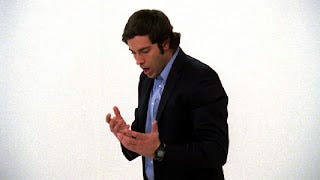
The power of that moment isn’t self-contained: it works because the writers spent 22 episodes developing the character to a point where he would definitively say “yes, I am a spy, this is my life,” something he would never have said at the start of the story. It’s the best long-form TV arc I’ve ever witnessed; even great shows like Lost didn’t truly become great until they shortened their seasons, while Chuck embraced a long episode order and made every last second count.
Not that the series was all arc all the time. Chuck could be arc-heavy one week and ‘standalone’ the next, but even if certain episodes didn’t deal with major plot points like Fulcrum or Orion, each and every story was uniquely designed to push the characters in new directions. In that way, every hour of season two was essential; unsurprisingly, every episode was also great. Not good, not passable, but great. I regard each and every one of the season’s 22 episodes as classics; not uniformly flawless, perhaps, but all wonderful in their own way. I would name highlights, but looking through the episode list, they’re all highlights, and they speak for themselves.
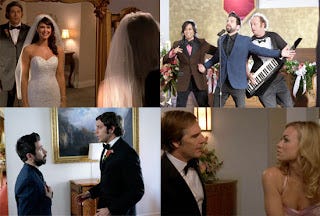
There is one episode I have to mention, though, the episode that stands above all others: “Chuck Versus the Ring,” the finale, and to this day my single favorite hour of TV. It may not be the best hour of TV I’ve seen from a purely objective, critical standpoint, but it is my favorite, 22-hours worth of arcs paying off in one expertly constructed episode. The first half deals with Ellie’s wedding, as Fulcrum comes party crashing, Jeffster! plays Mr. Roboto, and Casey and a team of commandos fly in through the roof to participate in the brawl. Brilliant stuff, but the episode only gets better from there, with Chuck giving his sister the gorgeous wedding she deserves out on the beach, Sarah’s silent admission to Bryce that she intends to stay with Chuck, and, of course, “I know Kung-Fu.” It is flawless entertainment, but really, it’s a symbol of the season as a whole.

I would be remiss if I ended this discussion of season two without mentioning the guest stars. How amazing they were! Michael Clarke Duncan as a Fulcrum agent in the premiere, John Larquette as British superspy Roan Montgomery, Tony Hale as obsessive new Buy More assistant manager (or Ass-Man, as he would say) Emmett Milbarge, Jordana Brewster as Chuck’s ex-girlfriend Jill, Morgan Fairchild and Bruce Boxleitner as Captain Awesome’s parents, Gary Cole as Sarah’s father, Reginald VelJohnson reprising his role as Sergeant Al Powell from “Die Hard” (yes, you read that right), Dominic Monaghan as a drugged-up rock star in the ingenious 3D episode, Andy Richter, Arnold Vosloo, and Ken Davitian as Fulcrum agents, and more. Phew. If you watched season two, reading those names will bring back a warm wave of happy memories. Chuck cast a lot of great people this year and made the most out of all of them – and this is before I mention the big two guest stars of season two, Scott Bakula as Stephen Bartowski, and Chevy Chase as the villainous Ted Roark. If I had the time, I’d talk about all the guest stars in detail, because they all brought something valuable to the show in their own unique ways.
I remember watching season two week-to-week and slowly realizing, over the course of the year, that this was truly one of my favorite shows, a program worth fighting for, a story I never wanted to say goodbye to. As ratings soured and it became clear that NBC was considering cancellation, I discovered I wasn’t alone in those thoughts: there was a vast online fan community, all committed to saving this wonderful show. Fansite ChuckTV.net organized a campaign wherein Chuck fans spoke out with their Five-Dollar Footlongs……okay, that didn’t sound right……I mean, they bought a lot of Subway sandwiches, and suddenly Chuck had the most effective product placement on TV.

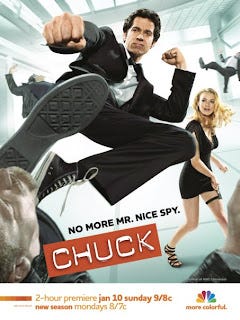
The rest, as they say, is history. Chuck was renewed for a third season. That season was extended by six episodes (19 total). Then it got a fourth season, which was extended by eleven episodes (24 total, the largest episode order of an hour-long on NBC that year). Finally, NBC rewarded the series and its fans with a final-season order of thirteen episodes. Unless NBC decides it’s in such dire straits that it needs a sixth season of Chuck (which could happen, quite honestly), this is it. It’s still the single most amazing achievement in the history of low-rated TV shows. Chuck went the distance in a way no low-rated show ever has before and, I think, ever will again. There will always be low-rated networks like NBC that have to renew small shows like Chuck because they are in crisis mode. There won’t always be a fanbase like the Chuck fans so devoted that said network chooses a particular low-rated show time and time again to plug holes in the schedule.
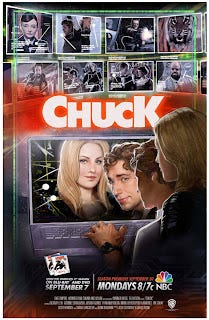
I won’t talk too much about the third and fourth seasons of Chuck; I blogged each episode on YourHub, and the fourth season reviews have been reposted here on my website. I don’t feel I have much more to say, except that my love for the show has never waned. Many fans were hard on season three, saying it stretched out Chuck and Sarah getting together for too long. Bull-hunky. Season three is an amazing work of art, darker than before but more rewarding for it. Because the last six episodes of the year were ordered at a later date, there’s a strange structure to the season, but it all works. I don’t think season three is quite as good as season two, but it’s very, very close, sharing the same gift for guest casting, arc structure, and music. Season four is the weakest season, I think, with more rough patches than before; on the other hand, it contains Yvonne Strahovski’s best material, the show’s best guest star and villain in Timothy Dalton’s Alexei Volkoff, and my second-favorite episode, “Chuck Versus the Cliffhanger.”
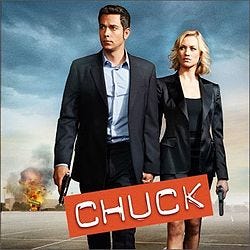
Though I love Chuck to death, and will be sad to see it go, I think this is the right time for the show to stop. As Captain Picard once taught us, all good things must come to an end, and in the case of Chuck, I’m happy that the creators have an end-date and can finish the show on their own terms. Many of the most highly-rated shows of all time never had that opportunity. I have faith in this crew to deliver one last great season, and to send this little-show-that-could out with one last, tremendous bang.
Before we embark on this final journey with Chuck and company, I’d lake to share one more memory: in the spring of 2010 (during season three), I was in Los Angeles with my Mom over Spring Break, looking at Colleges. One day we visited the Warner Bros. back-lot, the studio where WB-produced television shows (like Chuck) are shot. While waiting for the tour to start, I was looking around at all the merchandise on display in the gift shop, when my eyes were drawn to this hat:
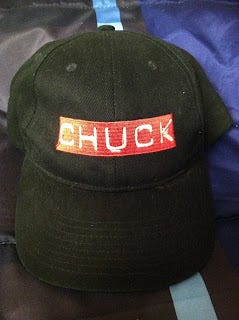
So simple. So elegant. Just the Chuck logo on black…but I had to have it. It was awesome. I bought it and wore it on the tour, which was an amazing experience. At first, we saw the general sets, locations built generically so that any production can use them. This includes a “New York” street that viewers often saw on Friends, a suburban neighborhood used in many shows, including the “Chuck Versus the Suburbs” episodes from season two (oddly enough, these houses are also where WB writers work), a house with an interior I recognized from “Terminator: The Sarah Connor Chronicles,” and a jungle location that I now see everywhere, from episodes of Chuck even to old movies like “Jurassic Park!”
After seeing all these awesome locations, I thought the tour couldn’t possibly get any better. But it did. For the next part of the tour, we were to go visit soundstages; our guide, a very nice fellow, saw my Chuck hat, and asked me if I was a fan. I told him I was, and he said that he was as well. Thus, the first soundstage he took us to was the Chuck courtyard, the area seen in every episode that branches off into Chuck/Sarah’s and Ellie/Awesome’s apartments. It was thoroughly amazing to behold, to think that this courtyard I watched every week actually existed in a large warehouse. The apartment interiors were actually located right there, just as you see them on the show, and we even got to go into Chuck’s apartment, which is just as geeky in real life as it is on screen. It took me a long time to scrape my jaw off the floor. I write about a lot of movies and TV shows, but to this day, the Chuck set is the only one I’ve ever visited, an experience so special that to this day, I wear my lucky Chuck hat frequently in the hopes that something similarly fantastic will occur.
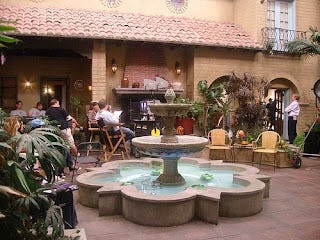
But you know what? Visiting the set isn’t my favorite Chuck memory; as amazing as it was to see Chuck’s “Tron” poster up close, it’s still not quite as special as simply watching Chuck, sharing it with my friends, family, and readers, participating in the most wonderful fan community I’ve ever experienced. I will be sad to see this show go for many reasons: I’ll mourn the thought of the sets I visited no longer existing; I’ll miss watching the wonderful cast on a weekly basis; but most of all, it’s that interaction with my readers, the larger fan community, and other Chuck fans that I’ll miss, because I don’t think another show will inspire this kind of universal love for a long, long time.
Chuck returns for its fifth and final season tomorrow night, October 28th, at 7:00 PM Mountain Time; my review will be posted an hour or so later.

